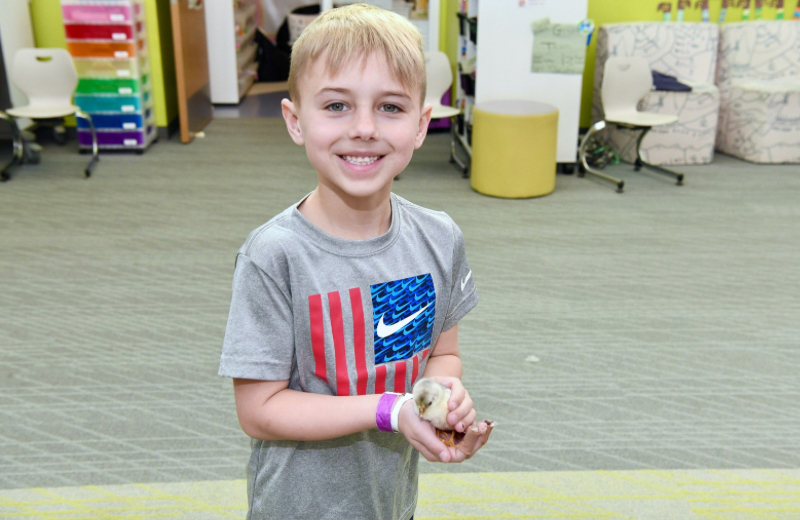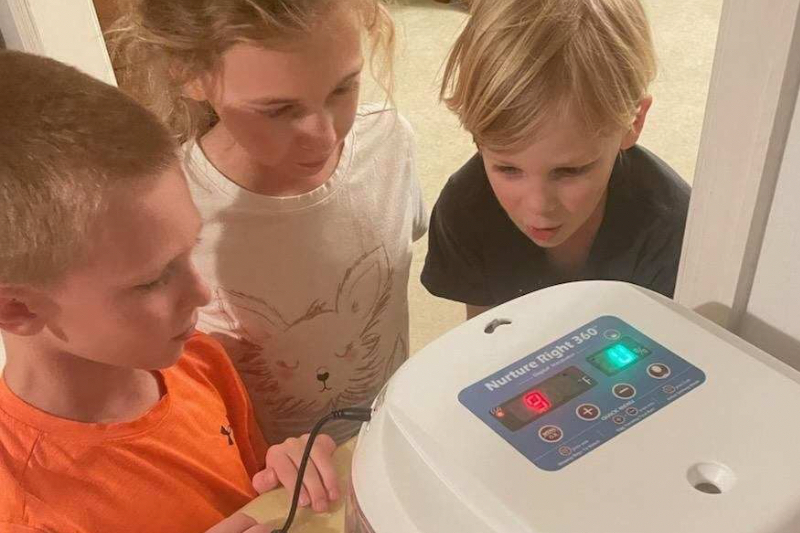


Peep into learning
Photos by Michele Walfred, Megan Willey and Kaitlin Rodgers June 24, 2025
4-H embryology programs hatch curiosity in classrooms
There’s nothing quite so sweet as gently cupping a fluffy day-old chick in your hands and hearing its first “peep, peep, peep.”
In spring, all across Delaware classrooms, libraries, afterschool programs and other locations, baby chicks, using a small appendage on their beak called an ‘egg tooth’ break their way out of their shell and meet their first humans — typically wide-eyed elementary students wearing broad smiles who welcome the little peepers into the world.
The experience is brought to the classroom by the University of Delaware 4-H Youth Development.
Delaware’s 4-H Embryology Program, part of a larger 4-H emphasis on STEM (science, technology, engineering and math), has delighted thousands of students for years, imprinting upon young minds a memorable experience of nature and science.
On a spring Monday, each classroom, homeschool group or child care center that signs up to participate receives an incubator, 12 pre-incubated eggs and educational materials geared toward an appropriate school grade level. In a few instances, the curriculum is adapted to middle and high school, libraries, centers for adults with special needs and even a correctional facility.
The process is timed just so. If all goes to plan, the chickens will hatch on Wednesdays and leave the school two days later for family farms.

The program's impact is powerful, reaching 42,000 participants in the past five years. Outreach from New Castle County’s program occasionally overflows into neighboring counties in Maryland and Pennsylvania. In 2025 alone, 10,500 people learned from the program statewide. Demand is high across the state.
“I have to turn people away,” said Jenny Trunfio, program coordinator and Extension agent in New Castle County.
The Albert H. Jones Elementary School in Christiana made the cut this year. First grade teacher Debbie Kelley hopes it won’t be the last time.
“It was such a great experience for all the kids and all the classrooms that participated had a wonderful time,” Kelley wrote in an email to Trunfio. “Please keep us in mind for next year. We would love to participate again if possible.”
Trunfio maintains 36 incubators, with about 31 in circulation. The New Castle County Council funds most of the program's cost. Schools pay a fee depending on the number of participants to offset expenses and curriculum materials. The fee is $75 per classroom in New Castle, $40 in Kent and $50 in Sussex.
“The chicks take 21 days to grow, and the classrooms get them on day 18,” Trunfio said. “The chicks are planned to hatch on a Wednesday, but I tell the teachers, just like humans, some come early and some come late.”
Each incubator contains a dozen eggs from six different breeds of layer chickens provided by UD’s farm in Newark — two each of Leghorns, White-Crested Black Polish, Rhode Island Reds, Barred Plymouth Rock, Ameraucana and (of course, no collection would be complete without) Blue Hens. Participants learn to identify the breed by the egg color and distinctive markings on their fluffy down.

Trunfio surveyed teachers statewide for feedback to emphasize the program’s value. According to a 2022 Cooperative Extension impact statement, 96% reported that their students’ perceptions of science were enhanced, while 84% reported an increase in their students’ patience, cooperation, sharing and responsibility.
Of the teachers surveyed, 91% reported that their students learned through seeing, listening, observing, experimenting and applying their knowledge to real-world situations.
One teacher’s favorite part of the program was “witnessing the students’ excitement and helping them to make cross-curricular connections with reading, writing, science and even math.”
At St. Mary Magdalen School in Wilmington, the classrooms at all eight grade levels welcomed spring with baby chicks. Third grader Camille was delighted.
“We waited and waited for them to hatch,” Camille said. “Then we got to hold them and pet them. We don’t get to have the experience if we don’t live on a farm with chickens, but we got to have it at school.”
A special focus in Sussex
Sussex County’s embryology program got off the ground with a grant from LEADelaware’s Class V fellows, who sponsor an initiative with an agriculture theme at the end of their two-year program. Kristin Cook, 4-H agent in Kent County and a fellow in Class V, knew Sussex wanted to replicate the program’s success in New Castle and Kent counties. Cook’s leadership cohort chose to raise funds to pay for the 16 incubators used in Sussex.
Because Sussex County is the largest producer of chickens in the U.S. per capita (the chicken-person ratio is 200:1), Jill Jackson, Sussex 4-H agent, partnered with Georgie Cartanza, statewide extension poultry agent, to add another layer of outreach for participants.

“In their everyday life, a child in Sussex County is more likely to see chickens transported in trucks or see poultry houses in the landscape, so we felt an additional lesson would be helpful,” Cartanza said.
Jackson also offers the experience to home-schooled groups. After she drops off the incubators and curriculum in the classrooms, Cartanza stops by to visit with students and explains the difference between chickens that provide food through their eggs and chickens that feed families with their meat.
She shares her experiences as a poultry grower. Questions stir among the students, and little hands shoot up in the air.
“How did the chick get inside the egg?” one student asks. “How do I know if the egg I eat has a baby chick inside?” another queries. Cartanza offers age-appropriate answers that seem to satisfy the young, curious minds.
Once in a while, the famous paradoxical question surfaces. ‘Which came first, the chicken or the egg?’ Cartanza offers an educational YouTube video, titled the same as the famous question, which once and for all lands on one side of the chicken conundrum (hint: It’s the egg).
Jackson solicits written feedback from the teachers at the end of each weeklong program. One teacher wrote, “The Cooperative Extension staff did an excellent job presenting information, from the teacher folders to the in-class presentation about the life cycle of a chicken.”
“We always have perfect attendance during chick week,” wrote another. “Lots of happy first graders!”
Of course, the children want to know what will happen to their temporary classmates.
The cute, downy, spotted and speckled fluff balls that entertain and educate for five days in Delaware classrooms will not end up on anyone’s plate. But when they grow up, their contribution of eggs most certainly will.
Contact Us
Have a UDaily story idea?
Contact us at ocm@udel.edu
Members of the press
Contact us at mediarelations@udel.edu or visit the Media Relations website

